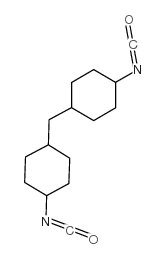4,4-二异氰酸酯二环己基甲烷

4,4-二异氰酸酯二环己基甲烷结构式

|
常用名 | 4,4-二异氰酸酯二环己基甲烷 | 英文名 | Methylene-bis(4-cyclohexylisocyanate) |
|---|---|---|---|---|
| CAS号 | 5124-30-1 | 分子量 | 262.34700 | |
| 密度 | 1.066 g/mL at 25 °C(lit.) | 沸点 | 168 °C / 1.5mmHg | |
| 分子式 | C15H22N2O2 | 熔点 | 25°C | |
| MSDS | 中文版 美版 | 闪点 | 211 ºC | |
| 符号 |


GHS06, GHS08 |
信号词 | Danger |
|
Multiple shape memory polymers based on laminates formed from thiol-click chemistry based polymerizations.
Soft Matter 11 , 6852-8, (2015) This investigation details the formation of polymer network trilayer laminates formed by thiol-X click chemistries, and their subsequent implementation and evaluation for quadruple shape memory behavior. Thiol-Michael addition and thiol-isocyanate-based cross... |
|
|
Functionalization of graphene oxide nanostructures improves photoluminescence and facilitates their use as optical probes in preclinical imaging.
Nanoscale 7 , 10410-20, (2015) Recently reported photoluminescent nanographene oxides (nGOs), i.e. nanographene oxidised with a sulfuric/nitric acid mixture (SNOx method), have tuneable photoluminescence and are scalable, simple and fast to produce optical probes. This material belongs to ... |
|
|
Fabrication of chiral amino acid ionic liquid modified magnetic multifunctional nanospheres for centrifugal chiral chromatography separation of racemates.
J. Chromatogr. A. 1400 , 40-6, (2015) As the rapid development of nanotechnology, the magnetic nanospheres modified with special chiral selective ligands show a great potentiality in enantiomeric separation. In this study, magnetic nanospheres modified with task-specific chiral ionic liquid were ... |
|
|
Degradation studies on segmented polyurethanes prepared with HMDI, PCL and different chain extenders.
Acta Biomater. 6(6) , 2035-44, (2010) Biodegradable segmented polyurethanes (BSPUs) were prepared with poly(caprolactone) as a soft segment, 4,4'-methylene bis (cyclohexyl isocyanate) and either butanediol (BSPU1) or dithioerythritol (BSPU2) as a chain extender. BSPU samples were characterized in... |
|
|
Preparation and surface characterization of HMDI-activated 316L stainless steel for coronary artery stents.
J. Biomed. Mater. Res. A 85(3) , 722-30, (2008) Poor compatibility between blood and metallic coronary artery stents is one reason for arterial restenosis. Immobilization of anticoagulant agents on the stent's surface is feasible for improving compatibility. We examined possible surface-coupling agents for... |
|
|
Comparison of clinical and experimental data from an animal model of pulmonary immunologic sensitivity.
Ann. Allergy 66(6) , 485-9, (1991) Isocyanates are highly reactive chemicals capable of causing a multitude of toxicologic effects including respiratory irritation, dermal irritation, contact sensitivity, and pulmonary hypersensitivity. In order to probe the mechanism(s) underlying these react... |
|
|
Contact sensitivity to hylene W.
Contact Dermatitis 6(5) , 353-4, (1980)
|
|
|
Experimental delayed hypersensitivity following inhalation of dicyclohexylmethane-4,4'-diisocyanate: a concentration-response relationship.
Toxicol. Appl. Pharmacol. 74(2) , 244-9, (1984) Exposure of workers to low-molecular-weight chemicals has been associated with delayed-onset hypersensitivity reactions in both the skin and the respiratory tract. The use of two animal models to examine factors affecting the production of delayed hypersensit... |
|
|
Extensive skin sensitization with minimal antibody production in guinea pigs as a result of exposure to dicyclohexylmethane-4,4'-diisocyanate.
Toxicol. Appl. Pharmacol. 65(2) , 291-301, (1982) It has been reported that workers exposed to dicyclohexylmethane-4,4′-diisocyanate (HMDI) developed dermal sensitization with little accompanying pulmonary sensitivity ( E. A. Emmett, 1976, J. Occup. Med., 18, 802–804; R. Israeli, V. Smirnov, and M. Sculsky, ... |
|
|
Use of dose-response data to compare the skin sensitizing abilities of dicyclohexylmethane-4,4'-diisocyanate and picryl chloride in two animal species.
Toxicol. Appl. Pharmacol. 78(3) , 445-50, (1985) Groups of English smooth-haired guinea pigs and BALB/cBy mice were exposed to dicyclohexylmethane-4,4'-diisocyanate (HMDI) and picryl chloride (PiCl) by topical exposure. Guinea pigs were challenged 7 days later by patch testing and responses graded at 24 hr.... |